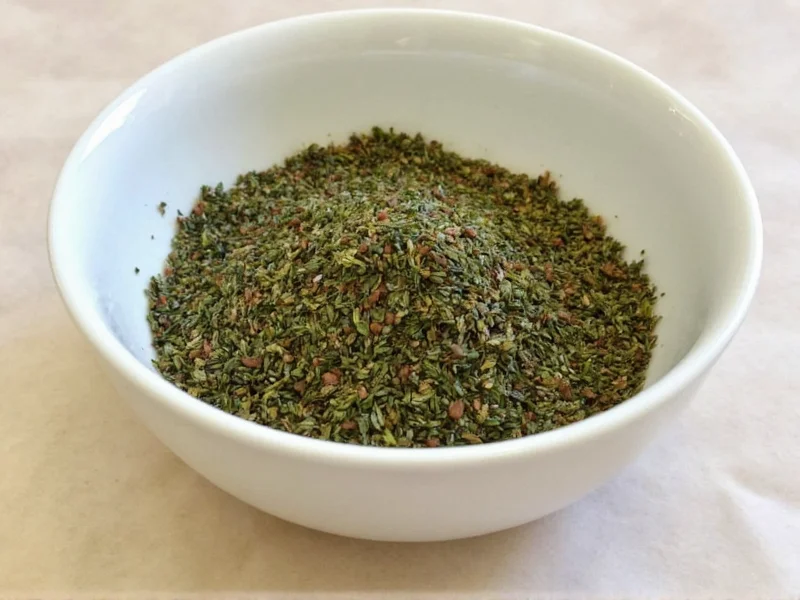The standard conversion ratio for fresh thyme to dried thyme is 3:1. This means you need three times as much fresh thyme as dried thyme in recipes. For example, if a recipe calls for 1 teaspoon of dried thyme, you should use 1 tablespoon (3 teaspoons) of fresh thyme instead. This conversion accounts for the concentration of flavor that occurs during the drying process.
Understanding Fresh Thyme to Dried Thyme Conversion
When substituting fresh thyme for dried in your cooking, understanding the proper conversion ratio is essential for achieving the intended flavor profile. The 3:1 ratio exists because the drying process removes moisture while concentrating the essential oils and flavor compounds in the herb.
Why the 3:1 Conversion Ratio Works
Thyme loses approximately 75-80% of its moisture content during drying. This concentration means dried thyme delivers a more potent flavor than its fresh counterpart. The essential oils that give thyme its distinctive aroma and taste become more concentrated as water evaporates.
When you use the correct fresh thyme to dried conversion ratio, you maintain the recipe's intended flavor balance. Using too much dried thyme can make dishes overly pungent, while insufficient dried thyme may result in under-seasoned food.
Practical Application in Cooking
Here's how to apply the fresh thyme converted to dried ratio in your kitchen:
| Dried Thyme | Fresh Thyme Equivalent |
|---|---|
| ¼ teaspoon | ¾ teaspoon |
| ½ teaspoon | 1½ teaspoons |
| 1 teaspoon | 1 tablespoon |
| 1½ teaspoons | 4½ teaspoons (1 tablespoon + 1½ teaspoons) |
| 1 tablespoon | 3 tablespoons |
Flavor Differences to Consider
While the 3:1 conversion provides a good starting point, remember that fresh and dried thyme have slightly different flavor profiles. Fresh thyme offers brighter, more citrusy notes, while dried thyme develops earthier, more concentrated flavors. When making the fresh thyme to dried substitution, consider these characteristics:
- Dried thyme works better in long-cooking dishes like stews and braises
- Fresh thyme shines in finishing dishes or in recipes with shorter cooking times
- Dried thyme has a longer shelf life but gradually loses potency over time
- Fresh thyme should be added later in the cooking process to preserve its delicate flavor
Storage Tips for Maximum Potency
To ensure accurate fresh thyme converted to dried measurements, proper storage matters:
Store fresh thyme wrapped in a slightly damp paper towel inside a plastic bag in the refrigerator for up to two weeks. For dried thyme, keep it in an airtight container away from heat and light. Properly stored dried thyme maintains optimal flavor for 6-12 months, though it remains safe to use beyond that timeframe with gradually diminishing potency.
Common Substitution Mistakes
Cooks often make these errors when converting fresh thyme to dried:
- Using equal amounts instead of adjusting for concentration
- Not accounting for the different flavor profiles
- Using old, stale dried thyme that has lost potency
- Adding dried thyme too late in the cooking process
When in doubt about your dried thyme's potency, start with a slightly smaller amount than the conversion suggests, then adjust to taste. Remember that the fresh thyme to dried conversion ratio serves as a guideline—your personal taste preferences and the specific dish you're preparing should ultimately guide your seasoning decisions.
Expert Tips for Perfect Herb Substitutions
Professional chefs recommend these additional considerations when working with thyme conversions:
- For delicate dishes, use 2:1 ratio instead of 3:1 to prevent overpowering flavors
- Crushing dried thyme between your fingers before adding releases more flavor
- Add dried thyme early in cooking to allow time for rehydration and flavor distribution
- Use fresh thyme stems in soups and stews, then remove before serving
Frequently Asked Questions
What is the exact conversion for fresh thyme to dried?
The precise conversion ratio is 3:1, meaning 1 tablespoon of fresh thyme equals 1 teaspoon of dried thyme. This accounts for the moisture loss during drying that concentrates the herb's flavor compounds.
Can I substitute dried thyme for fresh in all recipes?
While you can substitute dried thyme for fresh in most recipes, the substitution works best in cooked dishes rather than raw applications. For salads, garnishes, or dishes served cold, fresh thyme provides superior flavor and texture that dried thyme cannot replicate.
How do I adjust recipes when using older dried thyme?
Dried thyme loses potency over time. If your dried thyme is older than six months, increase the amount by 25-50% when converting from fresh. For example, use 1¼-1½ teaspoons of older dried thyme instead of 1 teaspoon when substituting for 1 tablespoon of fresh thyme.
Does the conversion ratio differ for other herbs?
Most tender herbs like basil, oregano, and mint follow the same 3:1 fresh to dried conversion ratio. However, more robust herbs like rosemary and sage use a 4:1 ratio due to their higher oil content. Always consider each herb's specific characteristics when making conversions.
How can I tell if my dried thyme has lost potency?
Fade color and weak aroma indicate diminished potency. Fresh dried thyme should have a vibrant green color and strong fragrance. If your thyme appears dull brown or has little scent when crushed, it's lost significant flavor and you'll need to use more than the standard conversion ratio.











 浙公网安备
33010002000092号
浙公网安备
33010002000092号 浙B2-20120091-4
浙B2-20120091-4